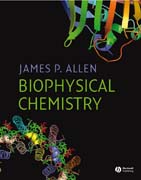
This text presents the subject of physical chemistry using a biological and biochemical approach. The treatment of the material is rigorous, but does not presume unrealistic prior knowledge of math concepts. INDICE: Preface.0. Basic thermodynamic and biochemical concepts.0.1 Fundamental thermodynamic concepts.States of matter.Pressure.Temperature.Volume, mass, and number.0.2 Properties of gases.The ideal gas laws.Gas Mixtures.0.3 Kinetic energy of gases.0.4 Real Gases.Liquifying gases for low temperature spectroscopy.0.5 Molecular Basis for Life.Cell Membranes.Amino acids.Classification of amino acids by their side chains.DNA and RNA.1. First law of thermodynamics.Systems.State Functions.First law of thermodynamics.1.1 Research Direction: Drug design I.Work.Specific heat.Internal energy for an ideal gas.Enthalpy.Dependence of specific heat on enthalpy.Derivative box: State Functions described using partial derivatives.Enthalpy changes of biochemical reactions.1.2 Research Direction: Global climate change.2. Second law of thermodynamics.Entropy.Entropy changes for reversible and irreversible processes.The second law of thermodynamics.Interpretation of entropy.Third law of thermodynamics.Gibbs energy.Relationship between the Gibbs free energy and the equilibrium constant.2.1 Research Direction: Drug design II.Gibbs free energy for an ideal gas.Using the Gibbs free energy.Carnot cycle and hybrid cars.Derivative box: Entropy as a state function.2.2 Research Direction: Nitrogen fixation.3. Phase diagrams, mixtures and chemical potential.Substances may exist in different phases.Phase diagrams and transitions.Chemical potential.Properties of lipids described using the chemical potential.3.1 Research Direction: lipid rafts.Determination of micelle formation using surface tension.Mixtures.Raoults law.Osmosis.3.2 Research Direction: Protein crystallization.4. Equilibria and reactions involving protons.Gibbs free energy minimum.Derivative box:Relationship between the Gibbs energy and equilibrium constant.Response of the equilibrium constant to condition changes.Acid-base equilibria.Protonation states of amino acid residues.Buffers.Buffering in the cardiovascular system.4.1 Research Direction: Proton coupled electron transfer and pathways.5. Oxidation/reduction reactions and bioenergetics.Oxidation/reduction reactions.Electrochemical cells.The Nernst Equation:.Midpoint potentials.Gibbs energy of formation and activity.Ionic strength.Adenosine triphosphate,ATP.Chemiosmotic hypothesis.5.1 Research Direction: Respiratory chain.5.2 Research Direction: ATP synthase.6. Kinetics and enzymes.Therate of a chemical reaction.Parallel first-order reactions.Sequential first order reactions.Second-order reactions.The order of a reaction.Reactions that approach equilibrium.Activation energy.6.1 Research Direction: Electron transfer I: Energetics.Derivative box Derivation of Marcus relationship.Enzymes.Enzymes lower the activation energy.Enzyme mechanisms.6.2 Research Directions: Dynamics in enzyme mechanism.Michaelis-Menten mechanism.Lineweaver-Burk equation.Enzyme activity.6.3 Research direction: The RNA world.7. The Boltzmann distribution and statistical thermodynamics.Probability.Boltzmann distribution.Partition function.Statistical thermodynamics.7.1 Research Direction: Protein foldingand prions.Prions.8. Quantum theory: Introduction and principles.Classical concepts.Experimental failures of classical physics.Blackbody radiation.Photoelectric effect.Atomic spectra.Principles of quantum theory.Wave Particle Duality.Schrödingers Equation.Born Interpretation.General approach for solving Schrödingers equation.Interpretation of quantum mechanics.Heisenberg Uncertainty Principle.A quantum mechanical world.8.1 Research Direction: Schrödingers cat.9. Particle in box and tunneling.One-dimensional particle in the box.Properties of the solutions.Energy and wavefunction.Symmetry.Wavelength.Probability.Average or expectation value.Transitions.9.1 Research Direction: Carotenoids.Two-dimensional particle in a box.Tunneling.9.2 Research Direction: Probing biological membranes.9.3 Research Direction: Electron transfer II: Distance dependence.10. Vibrational motion and infrared spectroscopy.Simple Harmonic Oscillator: Classical theory.Potential energy for the simple harmonic oscillator.Simple Harmonic Oscillator: Quantum theory.Derivative box: Solving Schrodingers equationfor the simple harmonic oscillator.Properties of the wavefunctions.Energy andwavefunction.Forbidden region.Transitions.Vibrational Spectra.10.1Research Direction: Hydrogenase.11. Atomic structure: Hydrogen atom and Multi-electron atoms.Schrodingers equation for the hydrogen atom.Derivative box: Solving Schrodingers equation for the hydrogen.Separation of variables.Angular Solution.Radial solution.Properties of the general solution.Angular Momentum.Orbitals.s-orbitals.p-orbitals.d-orbitals.Transitions.11.1 Research Direction: Hydrogen economy.Spin.Derivative box:Relativistic equations.Many electron atoms.Empirical constants.Self-consistent field theory (Hartree-Fock).Helium atom.Spin-orbital coupling.Periodic table.12. Chemical bonds and protein interactions.Schrodingers equation for the hydrogen molecule.Valence bonds.Huckel model.Interactions in proteins.Peptide bonds.Steric effects.Hydrogen bonds.Electrostatic interactions.Hydrophobic effects.Secondary structure.Determination of secondary structure using circular dichroism.12.1 Research Direction: Modeling protein structures.13. Electronic Transitions and optical spectroscopy.The nature of light.The Beer-Lambert law.Measuring absorption.Transitions.Derivation box: Relationship between the Einstein coefficient.Lasers.Selection Rules.Franck Condon Principle.The Relationship Between Emission and Absorption Spectra.The yield of fluorescence.Fluorescence Resonance Energy Transfer: FRET.Measuring fluorescence.Phosphorescence.13.1 Research Direction: Probing Energy transfer using 2D optical spectroscopy.13.2 Research Direction: Single molecule spectroscopy.Holliday junctions.14. X-ray diffraction and EXAFS.Diffraction theory.Braggs Law.Bravais lattices.Protein crystals.Diffraction from Crystals.Derivative box: Phasesof complex numbers.Phase determination.Molecular Replacement.Isomorphous Replacement.Anomalous Dispersion.Model Building.Experimental measurement of X-ray diffraction.Examples of protein structures.14.1 Research Direction: Nitrogenase.EXAFS.15. Magnetic resonance.Nuclear magnetic resonance.Chemical shifts.Spin-spin interactions.Pulse techniques.Two dimensional NMR:Nuclear Overhauser effect.NMR spectra of amino acids.15.1 Research Direction: Development of new NMRtechniques.15.2 Research Direction: Spinal Muscular Atrophy.Magnetic Resonance Imaging (MRI).Electron Spin Resonance.Hyperfine structure.Spin probes.ENDOR.15.3 Research Direction: heme proteins.15.4 Research Direction: ribonucleotidereductase.16. Signal transduction.Biochemical pathway for visual response.Spectroscopic studies of rhodopsin.Bacteriorhodopsin.Structural studies.Comparison of rhodopsins from different organisms.Rhodopsin proteins in visual response.17. Membrane potentials, transporters, and channels.Membrane potentials.Energetics of transport across membranes.Transporters.Ion channels.18. Molecular imaging.Green fluorescent protein,GFP.Mechanism of chromophore formation.FRET: fluorescence resonance energy transfer.Imaging of GFP in cells.Imaging in organisms.Radioactive decay.Positron emission tomography.Parkinsons disease.19. Photosynthesis.Energy transfer and light-harvesting complexes.Electron transfer, bacterial reaction centers, and photosystem I.Water oxidation
- ISBN: 978-1-4051-2436-2
- Editorial: Wiley-Blackwell
- Encuadernacion: Cartoné
- Páginas: 492
- Fecha Publicación: 09/07/2008
- Nº Volúmenes: 1
- Idioma: Inglés
